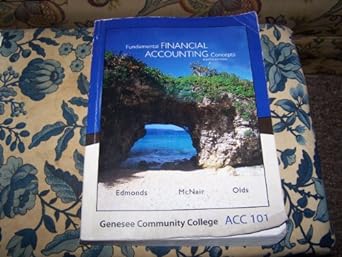Question
Multiple Choice Select the best answer to each question. Space is provided for computations after the quantitative questions. ____ 1. (CMA adapted) The costs of
Multiple Choice
Select the best answer to each question. Space is provided for computations after the quantitative questions.
____ 1. (CMA adapted) The costs of rework in a quality-improvement program are categorized as:
a. external failure costs.
b. internal failure costs.
c. training costs.
d. prevention costs.
e. appraisal costs.
____ 2. (CMA) The costs of using statistical quality control in a quality-improvement program are categorized as:
a. external failure costs.
b. internal failure costs.
c. training costs.
d. prevention costs.
e. appraisal costs.
____ 3. (CMA) All of the following costs are generally included in a costs of quality report except:
a. warranty claims.
b. forgone contribution margin on lost sales.
c. supplier evaluations.
d. design engineering.
e. quality training.
___ 4. (CMA) The following selected line items are from the Cost of Quality Report for Watson Company for May.
Cost
Rework
$ 725
Equipment maintenance
1,154
Product testing
786
Product repair
695
Watsons total prevention and appraisal costs for May are:
a. $786.
b. $1,154.
c. $1,849.
d. $1,940.
e. $2,665.
___ 5. Johns Custom Shirts has variable demand. Historically, demand has ranged from 20 to 40 shirts a day with an average of 30. John works 8 hours a day, 5 days a week. Each order he receives is to custom print one shirt and each shirt takes 12 minutes to print. The average waiting time (rounded to nearest tenth of a minute) is:
a. 1.8 minutes.
b. 14.1 minutes.
c. 18.0 minutes.
d. 36.0 minutes.
____ 6. Ashmore Company has two production departments, Cutting and Finishing. The Cutting Department is constrained by the speed of the cutting machines. The Finishing Department is constrained by the speed of the workers. The Finishing Department normally waits on work coming from the Cutting Department. Each department works an 8-hour day. If the Cutting Department were to begin work 2 hours earlier than the Finishing Department each day (thereby working a 10-hour day), the two departments would finish their work at about the same time. Not only would this change eliminate the bottleneck, but also it would increase production by 40 finished units per day. The number of units in finished goods inventory would remain the same. It costs $400 to operate the Cutting Department 2 more hours per day. The contribution margin is $15 per unit. If the Cutting Department operates 10 hours per day, the total production per day is:
a. 160 units.
b. 200 units.
c. 220 units.
d. 400 units.
____ 7. Using the information in question 6, and assuming the Cutting Department operates 10 hours per day, the total contribution margin per day:
a. increases by $200.
b. remains the same.
c. decreases by $200.
d. decreases by $400.
___ 8. Which of the following is not an action in managing bottleneck operations under the theory of constraints?
a. Reduce setup time and processing time at bottleneck operations.
b. Increase the efficiency and capacity of the bottleneck operation.
c. Process only those products that increase throughput margin.
d. Increase the efficiency and capacity of non-bottleneck operations.
Step by Step Solution
There are 3 Steps involved in it
Step: 1

Get Instant Access to Expert-Tailored Solutions
See step-by-step solutions with expert insights and AI powered tools for academic success
Step: 2

Step: 3

Ace Your Homework with AI
Get the answers you need in no time with our AI-driven, step-by-step assistance
Get Started


